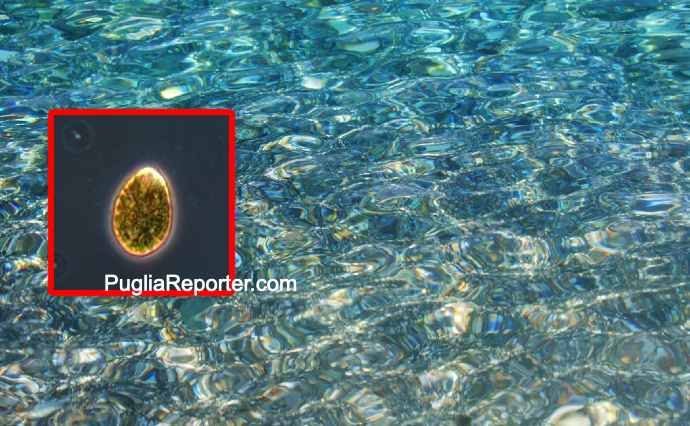 The entire stretch of sea coast between Torre Cala Rossa , to the left of Foce Capoiale, and the mouth of Canale Romondato, between Lido del Sole and Rodi Garganico , is perfectly suitable for swimming . Only in the vicinity of the Foci Capoiale and Varano , in the point where Lake Varano and the sea communicate, has a level of cyanobacteria been detected such as to suggest caution:
The entire stretch of sea coast between Torre Cala Rossa , to the left of Foce Capoiale, and the mouth of Canale Romondato, between Lido del Sole and Rodi Garganico , is perfectly suitable for swimming . Only in the vicinity of the Foci Capoiale and Varano , in the point where Lake Varano and the sea communicate, has a level of cyanobacteria been detected such as to suggest caution:
These are organisms that in the past were referred to with the term ” blue algae ” and have no connection with the faecal bacteria proper. This is the outcome of the extraordinary surveys that the Regional Agency for the prevention and protection of the environment carried out, at the request of the Puglia Region , until the whole day of Thursday 20 July , and which was discussed on Friday morning in the course of the meeting convened by the Prefect of Foggia, at the request of the mayor of Ischitella , which signaled some serious problems related to the lack of re-oxygenation of the lake waters. For the sake of completeness, the summary of the ARPA findings is reported below:
“Following the flowering of cyanobacteria detected in Lake Varano , and in the light of direct observations as well as reports of their presence also in the marine waters in front of it, starting from 07/14/2023, samplings were arranged by Arpa Puglia on the stretch of coast marina between Torre Cala Rossa (to the left of Foce Capoiale) and the mouth of Canale Romondato (between Lido del Sole and Rodi Gargano), supplementing what is already provided for by the bathing monitoring program pursuant to Legislative Decree 116/2008 and smsThe latest available results, relating to the laboratory analyzes for the samplings carried out on 07/20/2023, highlighted the presence of cyanobacteria in the sea with a density higher than 20,000,000 cells/L, the threshold value envisaged for the “Phase of Alert” from the Guidelines «Cyan-bacteria:
Guidelines for the management of cyano-bacteria blooms in bathing waters» (Istisan Reports 14/20), only in the areas near the Foci Capoiale and Varano (communication between the lake and the sea); in addition to the “Alert Phase”, with the exceeding of the value of 100,000,000 cells/L, we move on to the “Emergency Phase” for which the same Guidelines provide among the management measures (communication, information to citizens, etc. ) also any ordinance for the temporary ban on bathing, issued by the mayor of the competent area. Instead, the results for the remaining stretch of coast were all lower than 20,000,000 cells/L, thus falling within the so-called “Routine Phase” referred to in the aforementioned Guidelines, which does not require any risk management measure”.
“We also want to reiterate that cyanobacteria, in the past technically indicated with the term “blue algae”, are not directly linked to the microbiological contamination referred to in the fecal bacteria proper (e.g. Escherichia coli and intestinal Enterococci for Legislative Decree 116 /2008); however, it is understood how the similar denomination of the two different groups can lead to etymological confusion in non-experts of the subject. Furthermore, in the particular case of what is highlighted along the sea coast overlooking Lake Varano, one can probably assume the drift of the cyanobacteria bloom into the sea found in the waters of the lagoon itself, which flowed into the sea through its mouths (as confirmed by the analytical results obtained up to now). Finally, it is useful to point out that Arpa Puglia is closely following the phenomenon, as already mentioned through the intensification of monitoring activities, both in the lagoon and at sea” – specified by Arpa Puglia. However, it should be remembered that the Municipality of Bari has made it knownthat, as part of the risk management activities associated with the Ostreopsis ovata blooms (more commonly known as toxic algae) on the Italian coasts, ARPA Puglia – Natural Environments Operational Unit – Regional Sea Center communicated today that in the sample taken the last August 16 in San Giorgio, near the lido Il Trullo at the bathing point code IT016072006012 , a high concentration of Ostreopsis ovata was detected beyond the limitsindicated by the specific New Guidelines of the Ministry of Health (ISS 14/19). In case of certified flowering, it is advisable to avoid standing along rocky coasts during storm surges and it is advisable to limit the food consumption of marine organisms that could accumulate the toxin. In the presence of symptoms related to toxic seaweed, it is necessary to move away from the beach. In particular, children, the elderly and people suffering from respiratory system diseases (for example asthmatics and allergies) must be protected. Symptoms are usually transient and subside spontaneously within a few hours; if they persist or worsen, you should consult your doctor. To find out more about the microalga of the Ostreopsis ovata species, at this link . We also remind you that it is possible to monitor the updated results of the water analyzes through the interactive map on the Arpa Puglia website at the following link .
Regarding the PugliaReporter.com blog , we remind you that it is possible to receive all the news in real time from Telegram by registering at the following address > https://t.me/pugliareporter < from Instagram at the following address > instagram.com/puglia_reporter < as well as from Facebook by clicking ” like ” on Facebook.com/PugliaReporter and from Twitter at the following address > twitter.com/pugliareporter < . Also through Telegram it is also possible to send us reports in real time also withvideos and photos . It is also possible to write to us via Whatsapp to send us reports also with photos and videos by clicking here and subscribe to the Whatsapp group to receive our links by clicking here .



